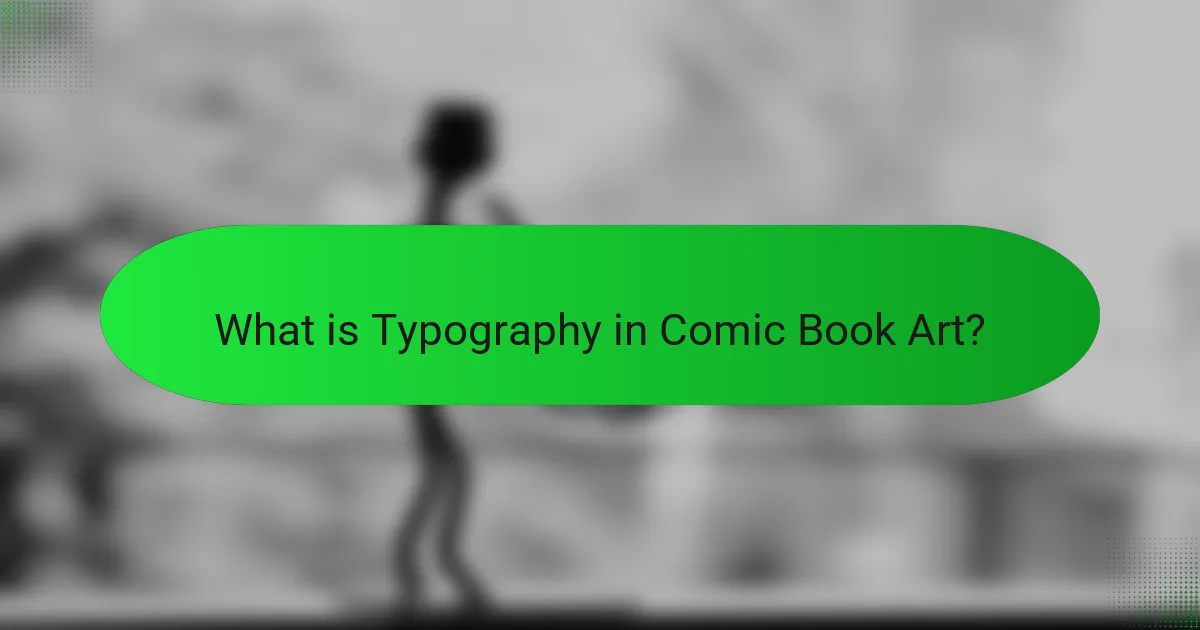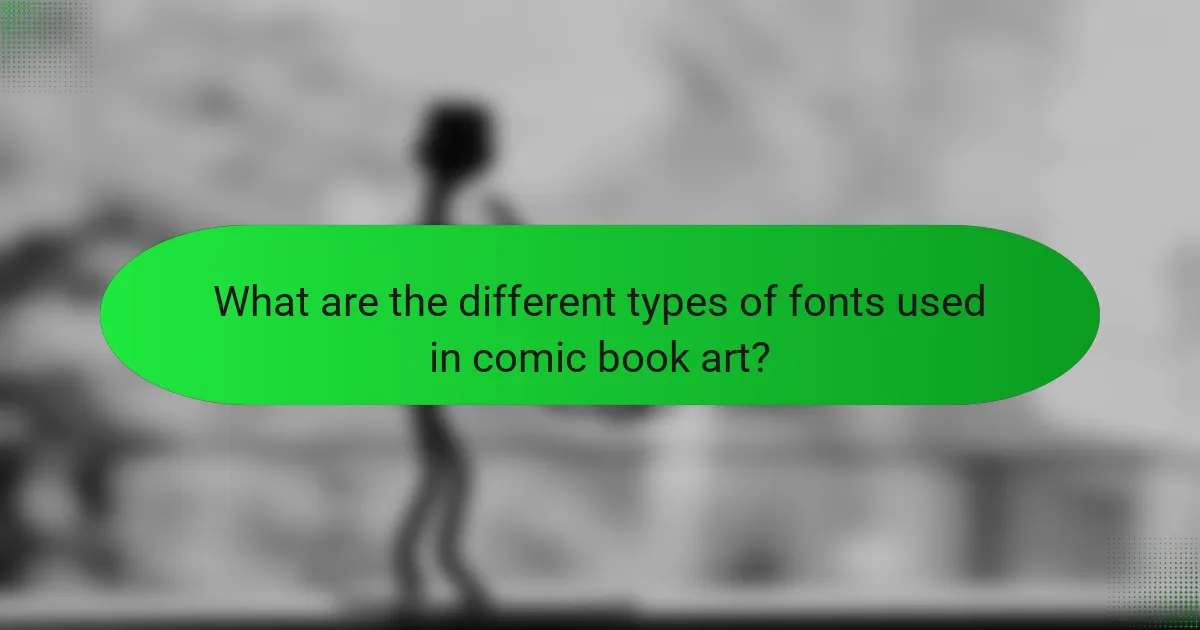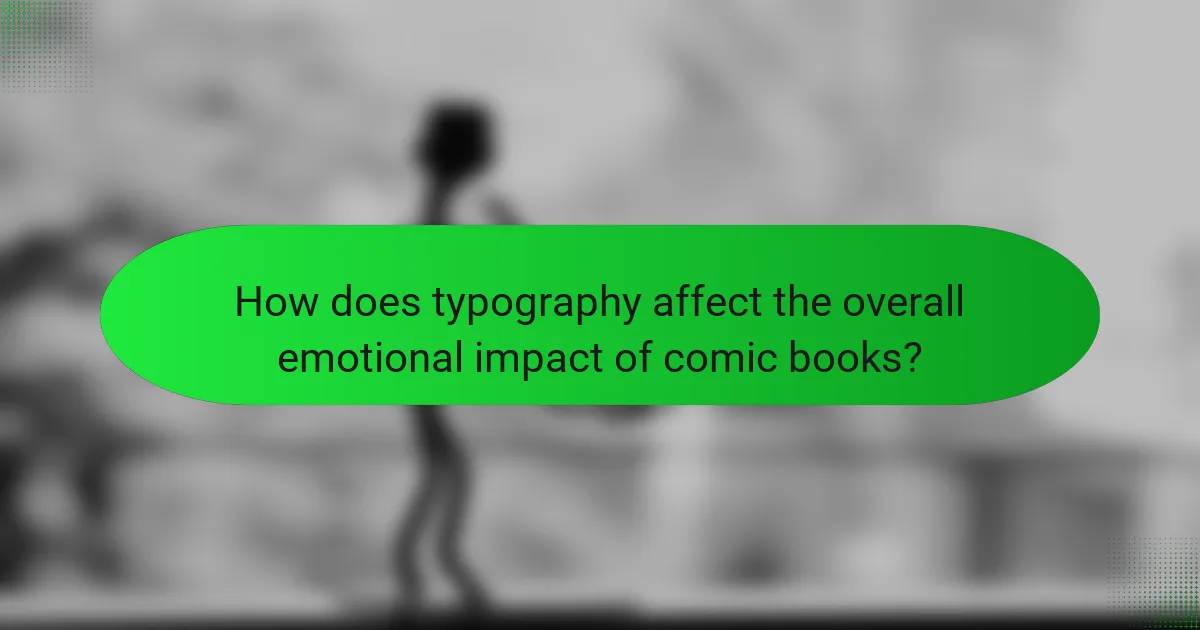Typography in comic book art refers to the design and arrangement of text within comic panels, which is crucial for conveying dialogue, sound effects, and narration. The choice of font impacts readability and emotional tone, with different styles such as sans-serif, serif, and script fonts evoking various feelings and enhancing storytelling. Effective typography not only complements the artwork but also significantly influences reader engagement and comprehension. Research indicates that clear typography improves legibility and can amplify the emotional experience of the narrative, making it an essential element in the comic book medium.

What is Typography in Comic Book Art?
Typography in comic book art refers to the design and arrangement of text within comic panels. It plays a crucial role in conveying dialogue, sound effects, and narration. The choice of font affects readability and emotional tone. Different fonts can evoke various feelings, enhancing the story’s impact. For example, bold fonts may indicate action or excitement. In contrast, script fonts can suggest intimacy or whimsy. Effective typography complements the artwork and guides the reader’s experience. Studies show that legible typography improves reader engagement in comics. Proper use of typography is essential for effective storytelling in this medium.
How does typography influence comic book storytelling?
Typography significantly influences comic book storytelling by shaping the reader’s emotional response and guiding narrative flow. The choice of font can convey tone and mood. For example, bold, jagged fonts can evoke tension or aggression, while softer, rounded fonts may suggest warmth or humor. Legibility is crucial; clear typography ensures that dialogue and narration are easily understood. Poorly chosen fonts can distract or confuse readers, disrupting the storytelling experience. Additionally, typography can establish character identity. Unique fonts can represent individual voices, enhancing characterization. Research shows that typography affects reader engagement. A study by the University of Reading found that well-designed typography can improve comprehension and retention of narrative content. Thus, typography is a vital element in comic book storytelling, influencing both emotional impact and reader interaction.
What are the key elements of typography in comic books?
The key elements of typography in comic books include font selection, legibility, and emotional impact. Font selection determines the tone and style of the comic. Common fonts like Comic Sans or custom hand-drawn styles are popular. Legibility ensures that text is easily read, even at small sizes. This is crucial for dialogue and captions. Emotional impact is achieved through typographic choices that match the narrative. For instance, bold fonts can convey excitement, while script fonts may evoke intimacy. These elements work together to enhance storytelling and reader engagement in comic books.
How does typography contribute to character development?
Typography shapes character development by influencing readers’ perceptions and emotions. The choice of font can reflect a character’s personality traits. For instance, bold and angular fonts may suggest aggression or strength. In contrast, softer, rounded fonts can evoke warmth or friendliness.
Additionally, typography can signify a character’s background or status. For example, a sophisticated serif font may indicate education or refinement. Conversely, a chaotic or distorted typeface might represent instability or madness.
Research shows that typography affects emotional responses. A study by Lindgaard et al. (2006) found that typeface style significantly impacts user perception and emotional engagement. This demonstrates that typography is a vital tool in comic book art for character development.
Why is legibility important in comic book typography?
Legibility is crucial in comic book typography because it ensures that readers can easily understand the text. Clear and readable fonts enhance the storytelling experience. When text is legible, it allows readers to focus on the visuals and narrative without distraction. Poor legibility can lead to confusion and misinterpretation of dialogue and captions. Studies show that readability affects comprehension; for instance, a 2015 study published in the Journal of Visual Literacy highlights that legible typography significantly improves reader engagement. Thus, effective typography directly influences the overall impact of comic book art.
What factors affect legibility in comic book fonts?
Factors affecting legibility in comic book fonts include font size, style, and spacing. Larger font sizes enhance readability. Bold styles can improve clarity against busy backgrounds. Line spacing affects how easily text can be read. Adequate letter spacing prevents characters from blending together. Contrast between text and background is crucial for visibility. The complexity of the font design can hinder quick reading. Simpler fonts generally offer better legibility. Additionally, the use of consistent styling throughout a comic aids reader comprehension. Research indicates that these elements collectively influence how effectively readers can process comic book text.
How can poor legibility impact reader experience?
Poor legibility negatively affects reader experience by hindering comprehension. When text is difficult to read, it disrupts the flow of the narrative. Readers may struggle to follow the story, leading to frustration. This can result in disengagement from the comic. Studies show that legibility influences reading speed and retention. For instance, research by Legge et al. (2007) indicates that clear typography improves understanding. Therefore, poor legibility can diminish the overall enjoyment of comic book art.

What are the different types of fonts used in comic book art?
Comic book art utilizes various types of fonts to convey different emotions and styles. Common font types include sans-serif, serif, and script fonts. Sans-serif fonts are often used for dialogue and narration due to their clarity. Serif fonts can add a classic or dramatic feel to the text. Script fonts are typically used for sound effects or to convey a character’s unique voice. Additionally, custom fonts are frequently created to match the artistic style of specific comic series. The choice of font impacts the overall legibility and emotional tone of the comic. Research indicates that font selection can significantly influence reader engagement and comprehension.
How do different font styles convey emotions in comics?
Different font styles convey emotions in comics through their visual characteristics and design choices. Bold fonts often express strength or intensity, while cursive or script fonts can evoke feelings of warmth or intimacy. Serif fonts may suggest tradition or seriousness, whereas sans-serif fonts typically convey modernity and simplicity.
The size of the font also plays a critical role; larger fonts can indicate shouting or urgency, while smaller fonts may suggest whispers or subtlety. Additionally, the use of color in font styles can enhance emotional impact; red can signify danger or passion, while blue might convey calmness or sadness.
Research by the American Psychological Association highlights that typography significantly affects reader perception and emotional response. This demonstrates that font styles are not merely aesthetic choices but are integral to storytelling in comics.
What are the characteristics of hand-drawn fonts?
Hand-drawn fonts are characterized by their organic and irregular shapes. They often exhibit variations in line thickness and spacing. These fonts can convey a sense of personality and emotion. Hand-drawn fonts typically lack the uniformity found in digital fonts. They may include imperfections that enhance their charm. This style often evokes a casual or playful tone. Many designers use hand-drawn fonts to create an inviting atmosphere. The uniqueness of each letter can make the text more engaging for readers.
How do serif and sans-serif fonts differ in emotional impact?
Serif fonts evoke a sense of tradition and reliability. They often convey seriousness and formality, making them suitable for print media. Research shows that serif fonts are perceived as more trustworthy in contexts like newspapers and books. Sans-serif fonts, on the other hand, project modernity and simplicity. They are often seen as more approachable and friendly, making them popular in digital media. Studies indicate that sans-serif fonts can enhance readability on screens. The emotional impact of serif fonts leans towards authority, while sans-serif fonts lean towards casualness.
What role does font size play in comic book design?
Font size in comic book design is crucial for readability and emotional impact. It determines how easily readers can engage with the text. Larger font sizes are often used for emphasis and to convey strong emotions. Smaller font sizes can indicate quieter moments or background dialogue. The choice of font size affects pacing and flow within the comic. Studies show that optimal font sizes enhance reader comprehension. For example, a font size of 10-12 points is commonly recommended for dialogue. In contrast, titles and sound effects may use larger sizes for dramatic effect. Overall, font size significantly influences the visual storytelling in comics.
How does font size affect readability and pacing?
Font size directly influences readability and pacing in text. Larger font sizes enhance readability by making letters more distinct and easier to recognize. Studies show that a font size of 12-14 points is optimal for most readers. Smaller font sizes can lead to eye strain and slower reading speeds.
Pacing is affected by font size as well. Larger text can create a sense of urgency or importance, encouraging quicker reading. Conversely, smaller text may slow down the reader, allowing for reflection on the content. Research indicates that readability decreases significantly when font size drops below 10 points.
In comic book art, effective font size selection can enhance storytelling. It guides the reader through the narrative flow and emotional tone. Therefore, choosing the appropriate font size is crucial for both readability and pacing in comic book typography.
What are the best practices for font size in dialogue vs. narration?
Dialogue should typically use a slightly larger font size than narration. This practice enhances readability and draws attention to character interactions. For example, a common standard is 10-12 points for narration and 12-14 points for dialogue. This distinction helps readers easily differentiate between spoken words and descriptive text. Research indicates that larger font sizes improve legibility, especially in dynamic visual contexts like comic books. Therefore, using a larger font for dialogue supports better engagement and emotional impact.

How does typography affect the overall emotional impact of comic books?
Typography significantly influences the emotional impact of comic books. The choice of font can evoke specific feelings in readers. For instance, bold and angular fonts often convey action and urgency. In contrast, softer, rounded fonts may evoke warmth and nostalgia.
Legibility is another crucial factor. Clear typography ensures that dialogue and narrative are easily understood. When readers can quickly grasp the text, they can better immerse themselves in the story.
Research indicates that typography can enhance mood and tone. A study by the University of Reading found that typeface affects the emotional response to written content. This demonstrates that the right typography can amplify the intended emotional experience in comic books.
Overall, typography is not just a design element; it is a powerful tool that shapes the reader’s emotional journey.
What techniques do artists use to evoke emotions through typography?
Artists use various techniques to evoke emotions through typography. They manipulate font styles to convey different feelings. For example, bold and angular fonts can suggest aggression or urgency. Conversely, soft, rounded fonts often evoke warmth and friendliness.
Color also plays a crucial role in emotional expression. Red can signify passion or danger, while blue may evoke calmness. Size and scale impact perception as well. Larger fonts can create a sense of importance or urgency, while smaller fonts may suggest intimacy or subtlety.
Spacing and alignment further influence emotional responses. Tight spacing can create tension, while ample white space can evoke tranquility. Additionally, incorporating texture can add depth and enhance the emotional tone.
These techniques are commonly used in comic book art to enhance storytelling. Artists carefully select typography to align with character emotions and narrative themes. This strategic use of typography significantly impacts the reader’s emotional experience.
How can typography enhance dramatic moments in a story?
Typography enhances dramatic moments in a story by visually conveying emotion and urgency. The choice of font style can evoke specific feelings. For instance, bold and jagged fonts can signify tension or chaos. In contrast, softer, rounded fonts may indicate calmness or vulnerability. Size also plays a crucial role; larger text can create emphasis and draw attention to key moments. Additionally, the use of color in typography can influence mood. Red text often suggests danger or passion, while blue can imply tranquility. Studies show that effective typography can significantly impact reader engagement and emotional response. For example, research by the American Psychological Association indicates that font choice affects comprehension and retention of narrative elements. Thus, thoughtful typography is essential in enhancing the storytelling experience.
What are examples of typography enhancing humor in comics?
Typography enhances humor in comics through various techniques. Examples include exaggerated fonts that reflect characters’ emotions. For instance, a loud character may use bold, oversized letters. This visually amplifies their voice and adds comedic effect. Additionally, playful fonts can convey irony or sarcasm. Comic strips often employ speech bubbles with quirky shapes to emphasize humor. Color choices also play a role; bright colors can make a joke feel more vibrant. Furthermore, onomatopoeic words like “BAM!” or “POW!” use typography to create comedic sound effects. These elements combine to enhance the overall humorous experience in comics.
What are common challenges faced in comic book typography?
Common challenges in comic book typography include legibility issues, font selection, and space constraints. Legibility can be affected by font style and size, making it hard for readers to follow dialogue. Choosing the right font is crucial, as it must match the tone of the story and character. Space constraints arise from panel designs, limiting text placement and size. Additionally, balancing text with artwork is essential to avoid overwhelming the visuals. Consistency in typography across issues is necessary for reader familiarity. These challenges require careful consideration to enhance storytelling without compromising clarity.
How can artists overcome issues with font choice and readability?
Artists can overcome issues with font choice and readability by selecting fonts that enhance clarity. Choosing sans-serif fonts often improves legibility in comic book art. Artists should also consider font size to ensure readability at various distances. High contrast between text and background colors aids in visibility. Limiting the number of font styles used in a single piece can reduce visual clutter. Testing fonts with a sample audience can provide valuable feedback on readability. Research indicates that readability significantly impacts audience engagement and comprehension. A study by Tullis and Albert (2008) found that appropriate font choice can enhance user experience in visual media.
What tools and software are available for effective typography in comics?
Tools and software for effective typography in comics include Adobe Illustrator, Adobe Photoshop, and Clip Studio Paint. Adobe Illustrator offers vector-based text manipulation, allowing for precise control over typography. Adobe Photoshop provides raster-based editing capabilities, ideal for integrating text into comic panels. Clip Studio Paint is designed specifically for comic artists, featuring specialized text tools and balloon creation. Other notable tools include Inkscape for free vector graphics editing and FontForge for font creation and editing. These tools enhance legibility and emotional impact in comic book art.
What tips can improve typography in comic book art?
Use clear and legible fonts to enhance typography in comic book art. Choose typefaces that match the tone of the story. Maintain consistent font usage throughout the comic for coherence. Vary font sizes to create visual hierarchy and guide reader attention. Use appropriate spacing between letters and words to improve readability. Ensure dialogue balloons are large enough to contain text comfortably. Consider the placement of text to avoid clutter and enhance flow. Use color contrast between text and background for better visibility.
How can artists choose the right font for their narrative style?
Artists can choose the right font for their narrative style by considering the tone and emotion of their story. Fonts convey specific feelings and characteristics. For instance, serif fonts often suggest tradition and reliability. In contrast, sans-serif fonts can appear modern and clean. Artists should also evaluate legibility, especially in comic book art where quick reading is essential. The size and weight of the font impact readability and emphasis. Additionally, artists can experiment with different font styles to match their unique artistic voice. Research shows that font choice significantly affects audience perception and engagement. Therefore, aligning the font with the narrative enhances the overall storytelling experience.
What are best practices for integrating typography with illustrations?
Best practices for integrating typography with illustrations include ensuring legibility and harmony. Typography should complement the illustration style. Use contrasting colors to enhance visibility. Maintain consistent font styles throughout the piece. Consider the placement of text to avoid clutter. Balance the visual weight of text and images. Use hierarchy to guide the reader’s eye. These practices enhance the overall impact of comic book art.
Typography in comic book art is the design and arrangement of text within comic panels, crucial for conveying dialogue, sound effects, and narration. This article explores how typography influences storytelling by shaping emotional responses, enhancing readability, and defining character identity. Key elements include font selection, legibility, and emotional impact, with a focus on the role of different font types and sizes in conveying tone and mood. It also addresses common challenges in typography and offers best practices for effective integration with illustrations, ultimately highlighting typography’s significant effect on reader engagement and comprehension.